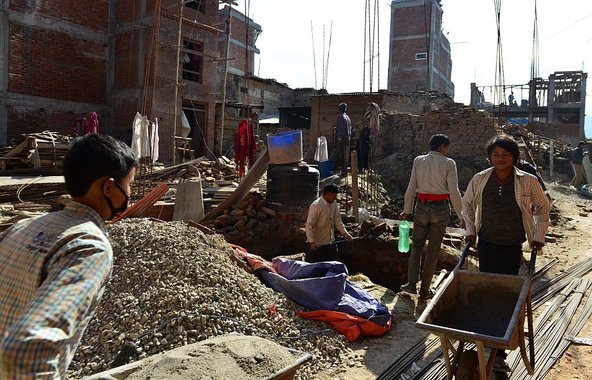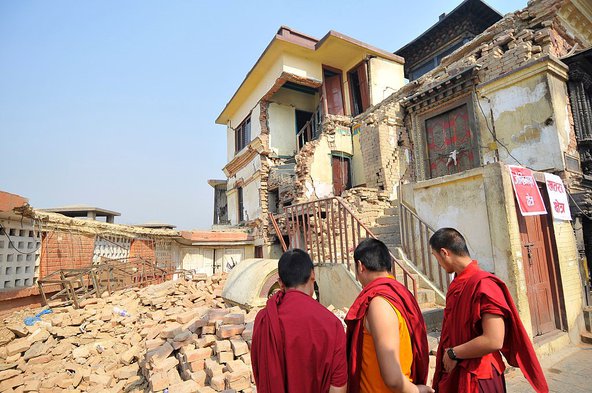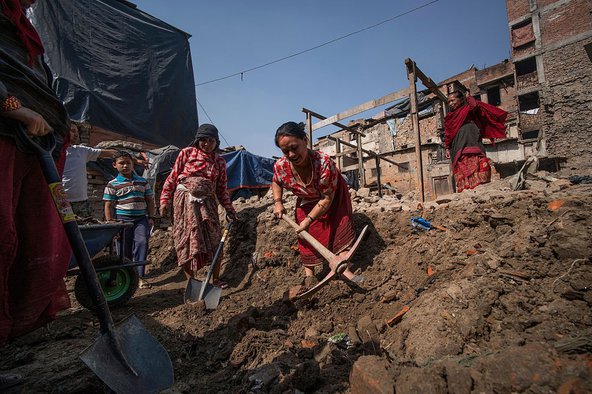How the Nepal earthquake continues to re-shape peoples' lives
by Professor Caroline Knowles
23 May 2018
People remember where they were on 25 April 2015 when an earthquake measuring 7.8 on the Richter scale hit Nepal. Followed by hundreds of aftershocks and another major earthquake on 17 May, an estimated 9,000 people died, and many more were injured and traumatised in ways we may never understand.
A team of researchers led by John Twigg at the Overseas Development Institute in London is in the Kathmandu Valley researching earthquake resilience – resilience is about the strategies people use in self-recovery. Funded under the British Academy’s Cities and Infrastructure Programme, the team is probing local priorities and knowledge of safer building techniques as people rebuild their homes and lives.
Holly Schofield and Luisa Miranda Morel, who work for Care International along with highly skilled interpreters, are the team on the ground in Bhaktapur, a densely populated urban area just along the Valley from Kathmandu. Walking around narrow densely populated streets, they tell me that following disasters people mostly recover through personal and community effort as (national and municipal) authorities are overwhelmed by the destruction and lack the resources to deal with it effectively.

Nepalese labourers work on the reconstruction of a house at Bhaktapur on the outskirts of Kathmandu. Photo credit: Getty Images
Trauma, loss and resilience
Trauma and loss is palpable in the stories people tell about their earthquake experiences. Running for the safety of open ground away from falling buildings is a logical first reaction to terror. But shock and grief soon give way to resilience as people set about rebuilding their homes and their lives. The 2015 earthquake transformed the built landscape – streets were filled with rubble, death and destruction. It also reorganised peoples’ lives in ways that the team are uncovering as they collect these stories.
The earthquake reworked the basic infrastructure of domestic shelter. We saw houses that were completely collapsed and where old people in particular were camping out, waiting for family help with rebuilding. Some preferred to live in partially-collapsed houses rather than move to temporary shelters that have become not-so-temporary.
Perhaps the earthquake has amplified social inequalities
Female-headed households and the elderly have always struggled to find adequate housing and the earthquake amplifies their difficulties. One elderly woman had her ‘nest’ – as she called it – rebuilt as a simple bamboo hut; plants are neatly arranged around the outside and lovingly watered. We saw houses still under construction where people lived while they gathered the money to put in windows and further floors. We saw rudimentary shelters intended to be a stopgap. And we saw beautiful new buildings that had been completed by those with better resources and larger debts. Perhaps the earthquake has amplified social inequalities.

Monks observing a destroyed Gumba around Swayambhunath Stupa premises on 25 April, 2016. Photo credit: Getty Images
Turning people into builders and reshaping the possibilities for making a living
The earthquake turned people into builders. Streets that had not long ago been filled with rubble were now filled with building materials and the soundscape of rebuilding – drilling, mixing, shoveling cement and inserting metal rods into concrete pillars for extra strength. Women, along with men, were carrying bricks and mixing cement and learning from the masons (skilled bricklayers) how to build. The team interviewed a woman who rebuilt her own house, redesigning it in the process to improve on the space and light of traditional interior designs.
The earthquake also boosted popular knowledge about seismic safety. As people explain their understanding of stronger building, it becomes obvious that they have learned important lessons from government information posters, leaflets and radio broadcasts.

Bidhya Laxmi Prajapati, 45, works with a pick axe as she clears debris at her former house damaged during the earthquake. Photo credit: Getty Images
At the same time, the disaster reshaped the possibilities for making a living as daily survival became a more urgent priority than rebuilding. Cut off from ancestral land and farm produce in the country, people must rely on their labour to eat. The relief effort that descended with rescue teams from different countries provided new streams of income for locals able to provide food, accommodation, supplies and other essentials.
Generating new disputes and formalising informal settlement
Meanwhile, the earthquake generated new disputes and amplified old ones within extended families and localities. Stacked in tall buildings, families have to think about how to claim, distribute and use the compensation and rebuilding grants the government are providing. The result is smaller and more fragmented families. Resolving family disputes involves selling ancestral farmland but land traditionally passes down male lines, leaving women disadvantaged.
The earthquake has caused rifts between neighbours, too. Resilient rebuilding in stronger materials further damages the weaker homes of neighbours. The deputy mayor tells Holly that the municipality is offering mediation to help neighbours resolve disputes.
The earthquake is formalising housing and historic land ownership, making the city a more regulated place to live
Cities like Kathmandu survive on informalities as people improvise and make life work for them as they go along. But the earthquake is formalising housing and historic land ownership. To claim government grants, people have to prove land title: a complex, bureaucratic and often contentious process. Formalisation hinders and supports the recovery process and makes the city a more regulated place to live.
Doing earthquake recovery differently
The earthquake changed everything. It could also change the ways in which governments and NGOs respond to disaster. As the team figures out what people know, need and prioritise, more effective responses by NGOs and governments to disasters can be devised. Doing earthquake recovery differently can be a major step forward in local empowerment, capacity and city building.
Professor Caroline Knowles BSc PhD is Professor of Sociology at Goldsmiths University of London and Director of the British Academy's Cities & Infrastructure Programme. Caroline writes about migration and circulations of material objects – some of the social forces constituting globalisation. She is particularly interested in cities, having done research in London, Hong Kong, Beijing, Fuzhou, Addis Ababa, Kuwait City and Seoul.


